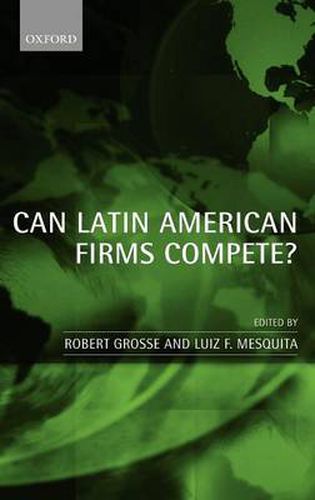Readings Newsletter
Become a Readings Member to make your shopping experience even easier.
Sign in or sign up for free!
You’re not far away from qualifying for FREE standard shipping within Australia
You’ve qualified for FREE standard shipping within Australia
The cart is loading…






In many discussions of globalization and growth, attention focuses on Asia, notably China, South Korea, and India. In contrast, ‘Can Latin American Firms Compete?’ looks at business developments in another key emerging market region, Latin America. It examines the success and failure that Latin American firms have met with, in their own markets and elsewhere in the world, the reasons behind these outcomes, and these firms’ future prospects. Including contributions from leading international experts on business in Latin America, the book draws on concepts from organization theory, industrial organization, economics, marketing, sociology, and political science. It includes sections on broad themes of competitiveness in Latin America, micro-level strategies of firms in specific sectors, the competitiveness of firms in specific countries, and competing in emerging markets. Cases examined range in size and sector, and include some of the largest firms in Latin America, such as as Embraer in Brazil, Quinenco (Luksic) in Chile, Techint in Argentina, Grupo Carso in Mexico, Cisneros in Venezuela, and Grupo Empresarial Antioqueno in Colombia. This well-informed book will be essential reading for academics, policy-makers, and those with a serious interest in business development in Latin America.
$9.00 standard shipping within Australia
FREE standard shipping within Australia for orders over $100.00
Express & International shipping calculated at checkout
In many discussions of globalization and growth, attention focuses on Asia, notably China, South Korea, and India. In contrast, ‘Can Latin American Firms Compete?’ looks at business developments in another key emerging market region, Latin America. It examines the success and failure that Latin American firms have met with, in their own markets and elsewhere in the world, the reasons behind these outcomes, and these firms’ future prospects. Including contributions from leading international experts on business in Latin America, the book draws on concepts from organization theory, industrial organization, economics, marketing, sociology, and political science. It includes sections on broad themes of competitiveness in Latin America, micro-level strategies of firms in specific sectors, the competitiveness of firms in specific countries, and competing in emerging markets. Cases examined range in size and sector, and include some of the largest firms in Latin America, such as as Embraer in Brazil, Quinenco (Luksic) in Chile, Techint in Argentina, Grupo Carso in Mexico, Cisneros in Venezuela, and Grupo Empresarial Antioqueno in Colombia. This well-informed book will be essential reading for academics, policy-makers, and those with a serious interest in business development in Latin America.